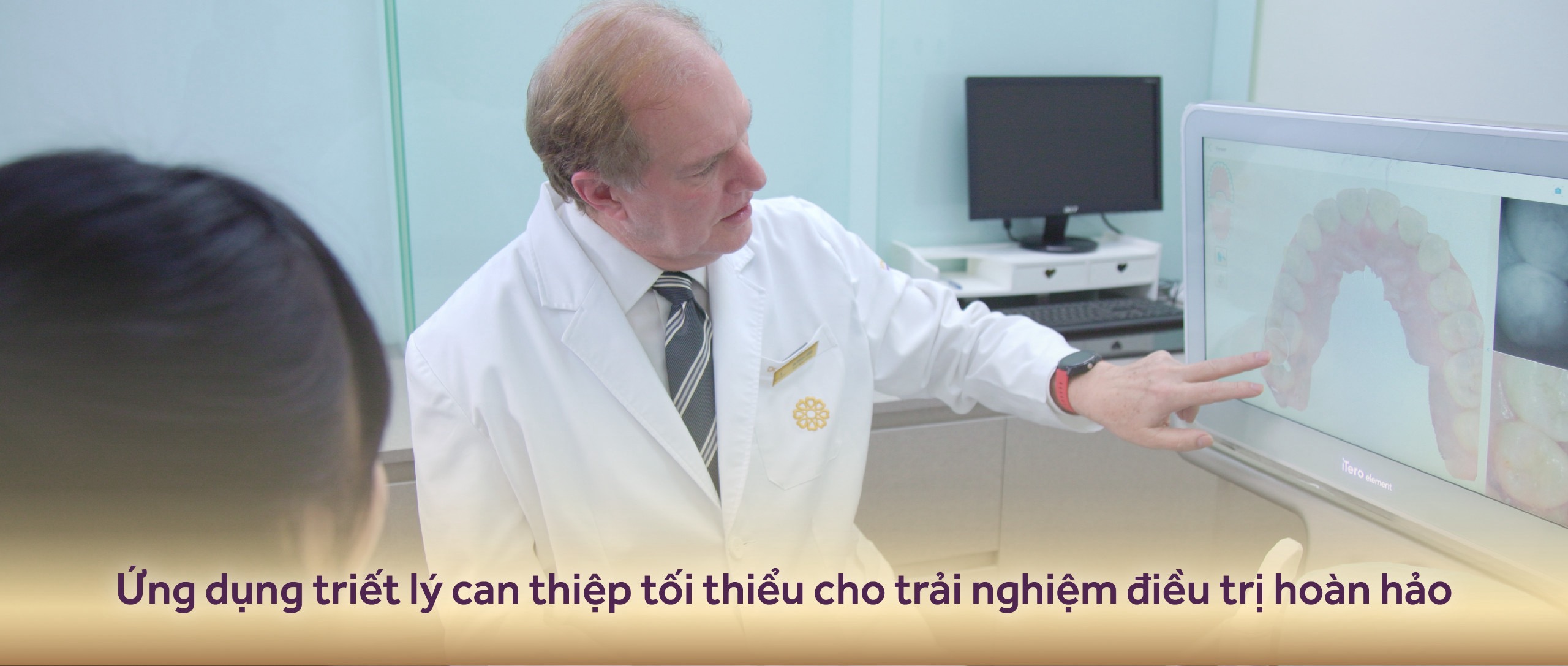1. Recognizing tooth decay in 5-year-old children
Children with tooth decay will progress in stages with different pathological manifestations. Parents can identify a 5-year-old child with severe or mild tooth decay through the following symptoms:
1.1. Expression of mild caries In the mild stage, decayed teeth will not form holes. If parents observe closely, they will see that the teeth will only change slightly in color. There may be white or light black spots on the crown of the tooth.
Children’s tooth enamel begins to be attacked by bacteria. However, this sign is not easy to recognize and parents are often subjective and ignored. The cause of this condition is that the baby often eats sweets and does not clean his teeth after eating.
Depending on the extent and location of tooth decay, signs and symptoms will vary. At first, when tooth decay first begins, children do not have any symptoms, when the teeth begin to get worse, they may experience some of the following symptoms:
Children’s teeth are discolored at some points on the chewing surface or between teeth; Frequent toothache makes children anorexic; Children’s teeth will also become more sensitive, painful when eating sweets, hot and cold, food often leads between teeth to make the baby uncomfortable; On the teeth appear small cavities; The surface around the cavity will change from brown to black. 1.2. At this stage, the baby’s teeth are gradually eroded by bacteria with the manifestation of dark brown holes appearing on the chewing surface of the teeth. The wormholes are small in size and get bigger and bigger. This expression can be easily observed if parents pay attention.
Baby can have bad breath, toothache and even become anorexic. At this point, maybe parents will immediately think about whether a 5-year-old child can pull a tooth. However, the tooth extraction of a 5-year-old baby needs to be carefully considered and instead follow up to see if the teeth are worse for the most optimal treatment.
At the decaying stage of enamel, tooth decay will continue to break down enamel, if parents look closely, they can see white spots gradually turning brown.
Bacteria also contribute to weak teeth, worn tooth enamel will form small holes called cavities. These cavities need to be cleaned and then welded / filled to avoid further tooth decay.
1.3. Severe stage tooth decay By this stage, children’s teeth already have large bacterial colonies. The teeth gradually weaken, the baby will feel severe pain and constant pain. Teeth also become more loose and chipped.
If left for a longer time, tooth decay can spread to the pulp. The sharp pain is also present so much that the child has to take pain relievers.
Also in this stage bacteria begin to attack the dentin under the enamel. The dentin is usually softer and more sensitive to the action of acids, so caries bacteria grow very quickly during this stage.
The most typical manifestation when children have severe tooth decay is that they often feel sensitive, more sensitive to hot or cold foods.
1.1. Expression of mild caries In the mild stage, decayed teeth will not form holes. If parents observe closely, they will see that the teeth will only change slightly in color. There may be white or light black spots on the crown of the tooth.
Children’s tooth enamel begins to be attacked by bacteria. However, this sign is not easy to recognize and parents are often subjective and ignored. The cause of this condition is that the baby often eats sweets and does not clean his teeth after eating.
Depending on the extent and location of tooth decay, signs and symptoms will vary. At first, when tooth decay first begins, children do not have any symptoms, when the teeth begin to get worse, they may experience some of the following symptoms:
Children’s teeth are discolored at some points on the chewing surface or between teeth; Frequent toothache makes children anorexic; Children’s teeth will also become more sensitive, painful when eating sweets, hot and cold, food often leads between teeth to make the baby uncomfortable; On the teeth appear small cavities; The surface around the cavity will change from brown to black. 1.2. At this stage, the baby’s teeth are gradually eroded by bacteria with the manifestation of dark brown holes appearing on the chewing surface of the teeth. The wormholes are small in size and get bigger and bigger. This expression can be easily observed if parents pay attention.
Baby can have bad breath, toothache and even become anorexic. At this point, maybe parents will immediately think about whether a 5-year-old child can pull a tooth. However, the tooth extraction of a 5-year-old baby needs to be carefully considered and instead follow up to see if the teeth are worse for the most optimal treatment.
At the decaying stage of enamel, tooth decay will continue to break down enamel, if parents look closely, they can see white spots gradually turning brown.
Bacteria also contribute to weak teeth, worn tooth enamel will form small holes called cavities. These cavities need to be cleaned and then welded / filled to avoid further tooth decay.
1.3. Severe stage tooth decay By this stage, children’s teeth already have large bacterial colonies. The teeth gradually weaken, the baby will feel severe pain and constant pain. Teeth also become more loose and chipped.
If left for a longer time, tooth decay can spread to the pulp. The sharp pain is also present so much that the child has to take pain relievers.
Also in this stage bacteria begin to attack the dentin under the enamel. The dentin is usually softer and more sensitive to the action of acids, so caries bacteria grow very quickly during this stage.
The most typical manifestation when children have severe tooth decay is that they often feel sensitive, more sensitive to hot or cold foods.
2. So can a 5-year-old child have teeth extracted?
Baby teeth play a very important role in chewing as well as supporting the child’s pronunciation. Therefore, having a healthy and beautiful long-term teeth is what dentists often aim for when treating baby tooth decay. Especially for 5-year-old children, if they have not yet reached the age of teeth replacement, they should best preserve their teeth, this will help the permanent teeth to grow up without being misaligned, crooked or protruding.
The cases of early extraction of baby teeth mostly affect the oral health of children. Not only does it have a bad impact on the teeth, but removing the baby’s teeth too soon also causes the child’s jaw bone to develop slowly, leading to narrowing of the jaw or lack of space for teeth to grow.
Thus, for the question “Can a 5-year-old child have a tooth extracted?” Then the doctor recommends that it should not be extracted, unless the child begins to replace baby teeth or meets one of the following mandatory cases:
Baby teeth of children have root infections, which are at risk of causing serious health problems. enamel deficiency and tooth abscess; Baby teeth with completely dead pulp are susceptible to bacterial infection down to the permanent tooth germ below; Children’s teeth with severe caries, treated many times but there is no sign of relief, they need to be removed to prevent the decay from spreading to other teeth as well as the permanent tooth germ. 3. Methods of tooth decay treatment instead of tooth extraction for children Performing tooth decay for children too early will cause many serious problems. Especially, it reduces the ability to chew food, the speed of food absorption as well as slow growth of the jawbone. So if we don’t remove it, what do we need to do to treat the damaged baby teeth?
Below are methods to treat tooth decay instead of tooth extraction for 5-year-old children:
Remineralization Remineralization of children’s teeth is the process of adding important minerals to teeth such as calcium and phosphorus in the enamel layer. This method will help restore lost enamel and make teeth whiter and fuller.
This method is used to treat new cases of tooth decay in children. Has the advantage of not causing pain and affecting the child’s oral cavity.
When performing this method, the doctors will use Calcium, Phosphate, Flour… to cover the cavities on the child’s teeth. This process will help rebuild the damaged tooth enamel. It also prevents the growth of harmful bacteria in the teeth.
Filling for children Teeth filling is a method used to restore chewing function and aesthetics of teeth damaged by tooth decay.
The doctor will use materials such as composite combined with laser and halogen light to harden the composite and fix it to the real tooth. For severely decayed teeth, it is necessary to take the pulp and fill it up, seal the cavity for the child to remove all infections as well as harmful bacteria.
In some cases, the doctor will consider if a 5-year-old child can have a tooth extracted. If extraction is not required, the restoration will be applied by one of the two methods above. Otherwise, it will have to be extracted early and cared for according to its own regimen so as not to affect the permanent teething stage in the child.
4. Teach parents to take care of their children’s daily oral care Proper dental care for children is the best method to prevent dental complications. Ensure that when children grow up, they will have strong teeth from the inside out. To do this, parents need to:
Create oral hygiene habits for children from the time the first baby tooth comes in until the child is 3 years old. Parents can teach children how to rinse their mouth, observe their teeth after eating, take toothpaste as well as practice brushing their teeth twice a day…; Adjust children’s bad habits if they often suck their thumbs, bite objects and grind their teeth… Because these habits can directly affect the bones of the teeth as well as the jaw. Over time, this will affect the development of the jaw; Feed children with adequate nutrients, enough calcium and vitamins for their teeth to develop steadily with age. Limit children to eat sweets such as chocolate, candy, ice cream… Because sweets are the main cause of tooth decay in children today; Make children aware not to put dirty things in their mouth to bite or suck. Especially wash your hands before eating, do not put dirty hands on your teeth. Eat only clean, well-cooked and healthy food. Thus, 5-year-old children can have their teeth extracted no longer depending on the stage of tooth decay as well as the time of tooth replacement. To avoid this concern, what parents need to do is take good care of their baby’s baby teeth.
At this age, in addition to dental problems, the baby will likely have many other diseases. At the age of 3-6 years old, children are very active, love to observe and explore. The baby’s health is also very easily affected by environmental factors, very susceptible to diseases of the mouth, ears – nose – throat, eyesight, nutrition, height, hepatitis B… like adults. Doctors recommend that from the age of 4, children should have regular health checkups once a year like adults to promptly detect abnormal health problems. In particular, when the baby has symptoms of fatigue, anorexia or stops eating, the child should immediately go to a specialist for advice, monitoring and treatment.
Vinmec offers a general health check-up package for children under 18 years old with comprehensive examination services. The baby will be examined by pediatricians with a full range of specialties: cardiology, endocrinology, neurology, hepatobiliary, psychology, nutrition… and supported by specialized specialties. as Regenerative Medicine treatment and rehabilitation for children with autism. In Vietnam, there are very few hospitals with full specialized specialties like Vinmec’s Pediatrics department, providing the best treatment results.
The cases of early extraction of baby teeth mostly affect the oral health of children. Not only does it have a bad impact on the teeth, but removing the baby’s teeth too soon also causes the child’s jaw bone to develop slowly, leading to narrowing of the jaw or lack of space for teeth to grow.
Thus, for the question “Can a 5-year-old child have a tooth extracted?” Then the doctor recommends that it should not be extracted, unless the child begins to replace baby teeth or meets one of the following mandatory cases:
Baby teeth of children have root infections, which are at risk of causing serious health problems. enamel deficiency and tooth abscess; Baby teeth with completely dead pulp are susceptible to bacterial infection down to the permanent tooth germ below; Children’s teeth with severe caries, treated many times but there is no sign of relief, they need to be removed to prevent the decay from spreading to other teeth as well as the permanent tooth germ. 3. Methods of tooth decay treatment instead of tooth extraction for children Performing tooth decay for children too early will cause many serious problems. Especially, it reduces the ability to chew food, the speed of food absorption as well as slow growth of the jawbone. So if we don’t remove it, what do we need to do to treat the damaged baby teeth?
Below are methods to treat tooth decay instead of tooth extraction for 5-year-old children:
Remineralization Remineralization of children’s teeth is the process of adding important minerals to teeth such as calcium and phosphorus in the enamel layer. This method will help restore lost enamel and make teeth whiter and fuller.
This method is used to treat new cases of tooth decay in children. Has the advantage of not causing pain and affecting the child’s oral cavity.
When performing this method, the doctors will use Calcium, Phosphate, Flour… to cover the cavities on the child’s teeth. This process will help rebuild the damaged tooth enamel. It also prevents the growth of harmful bacteria in the teeth.
Filling for children Teeth filling is a method used to restore chewing function and aesthetics of teeth damaged by tooth decay.
The doctor will use materials such as composite combined with laser and halogen light to harden the composite and fix it to the real tooth. For severely decayed teeth, it is necessary to take the pulp and fill it up, seal the cavity for the child to remove all infections as well as harmful bacteria.
In some cases, the doctor will consider if a 5-year-old child can have a tooth extracted. If extraction is not required, the restoration will be applied by one of the two methods above. Otherwise, it will have to be extracted early and cared for according to its own regimen so as not to affect the permanent teething stage in the child.
4. Teach parents to take care of their children’s daily oral care Proper dental care for children is the best method to prevent dental complications. Ensure that when children grow up, they will have strong teeth from the inside out. To do this, parents need to:
Create oral hygiene habits for children from the time the first baby tooth comes in until the child is 3 years old. Parents can teach children how to rinse their mouth, observe their teeth after eating, take toothpaste as well as practice brushing their teeth twice a day…; Adjust children’s bad habits if they often suck their thumbs, bite objects and grind their teeth… Because these habits can directly affect the bones of the teeth as well as the jaw. Over time, this will affect the development of the jaw; Feed children with adequate nutrients, enough calcium and vitamins for their teeth to develop steadily with age. Limit children to eat sweets such as chocolate, candy, ice cream… Because sweets are the main cause of tooth decay in children today; Make children aware not to put dirty things in their mouth to bite or suck. Especially wash your hands before eating, do not put dirty hands on your teeth. Eat only clean, well-cooked and healthy food. Thus, 5-year-old children can have their teeth extracted no longer depending on the stage of tooth decay as well as the time of tooth replacement. To avoid this concern, what parents need to do is take good care of their baby’s baby teeth.
At this age, in addition to dental problems, the baby will likely have many other diseases. At the age of 3-6 years old, children are very active, love to observe and explore. The baby’s health is also very easily affected by environmental factors, very susceptible to diseases of the mouth, ears – nose – throat, eyesight, nutrition, height, hepatitis B… like adults. Doctors recommend that from the age of 4, children should have regular health checkups once a year like adults to promptly detect abnormal health problems. In particular, when the baby has symptoms of fatigue, anorexia or stops eating, the child should immediately go to a specialist for advice, monitoring and treatment.
Vinmec offers a general health check-up package for children under 18 years old with comprehensive examination services. The baby will be examined by pediatricians with a full range of specialties: cardiology, endocrinology, neurology, hepatobiliary, psychology, nutrition… and supported by specialized specialties. as Regenerative Medicine treatment and rehabilitation for children with autism. In Vietnam, there are very few hospitals with full specialized specialties like Vinmec’s Pediatrics department, providing the best treatment results.




